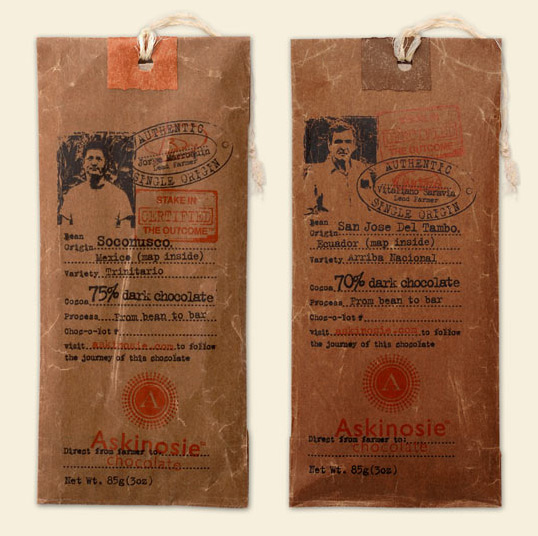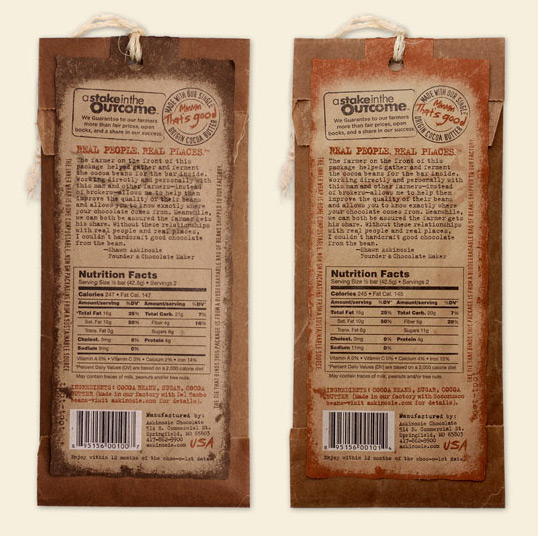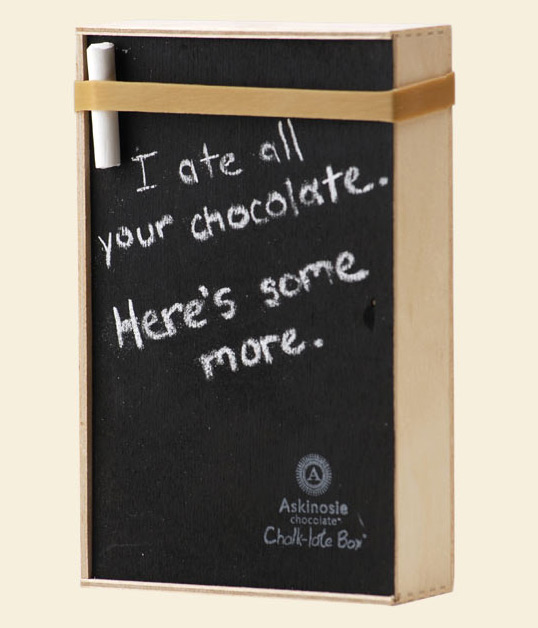
More people are becoming aware of the planets current environmental situation and are subsequently executing changes in an attempt to make a reduction in the amount of negative impacts we have on our planet. However, as identified in the previous post, it has become inarguably prominent that we all need to make the necessary sacrifices in order to contribute a difference...a requirement which is currently not completely being achieved. For example, the ideology of our populous switching to electrical cars is an environmentally valuable concept, however, somewhat impractical if you persist in enabling petrol heads/boy racers to unnecessarily burn fossil fuels at makeshift drag races at an alarming rate...you cannot have half a populous make sacrifices and the other half not, it would be counter-productive as the negative impact would most likely cancel out the positive.

One method of advertising a greener lifestyle is through altering the types of materials utilised in the process of mass-production, some companies are beginning to change from synthetic to more natural and renewable resources. The utilisation of natural/renewable materials automatically offers an increasingly favourable approach to production, as the product resultant of the process often witholds idealistic components that is environmentally more beneficial. Biodegradability and re-useability are just two of these components, and they are increasingly being incorporated into our modern day packaging, as the New York Times indicates below (http://www.nytimes.com/2010/06/12/business/energy-environment/12sustain.html?_r=0)...
"Around the globe, a growing number of manufacturers are including more recyclable or biodegradable components into products. Companies making changes run the gamut — there are furniture makers, carpet manufacturers, clothing retailers and makers of shampoos and household cleaners. And with big-box retailers like Wal-Mart joining in, industry analysts say the sustainable philosophy is no longer viewed as the province of high-end sellers like Nike or Herman Miller, the furniture maker. In 2008 alone, American consumers doubled their spending on sustainable products and services to an estimated $500 billion, according to a survey that polled more than a 1,000 people by Penn Schoen Berland Associates, a market research firm that studies the green economy."
Throughout history we have utilised natural materials to create a variation of different products, however, our advancement in both technology and ingenuity has resulted in a consumerist obsession, this has thus seen the introduction of man-made alternatives that apparently boasts superiority. An increase in the production and the request for unnecessary novelty items has led to a complete disregard towards any impact we subsequently have on the environment. Research has been increasingly focalised around the development of man made modern materials and the technology in which they are produced, however, in recent years natural materials are beginning to be re-introduced as a viable alternative to our synthetic options.
"Because the packaging industry uses such a vast range of materials across a multitude of applications and technologies, it has the opportunity to benefit from increasing pressure to use environmental and sustainable materials. Increasing demand from governments, international organisations and society to use sustainable and environmentally friendly materials is forcing many industries to reconsider the enormous wealth of natural materials available for use in a variety of everyday applications. Combining the innate properties of natural materials with modern technological advances will enable the development of totally new and innovative products." Description taken from the following website, http://www.woolcool.com/wp-content/uploads/2014/04/Natural-Materials-article.pdf.

Additionally, companies are beginning to understand the importance of acknowledging the environmental impact that their products have, we're recognizing that natural materials are available and work just as well as some synthetic alternatives. The ideology of sustainability is becoming ever-present in the selections made by businesses, new laws are making companies entirely responsible for their products sustainability. We have began encouraging our industries to make a reduction in the utilisation of finite resources, it is this encouragement combined with necessary industrial, social and environmental education that is imperative if we are to create a stimulus towards natural materials that reinforces knowledge, alters perceptions and influences recognition.
"The packaging industry as a whole should embrace the opportunities that the sustainability issues offer by researching, developing and commercialising natural materials for packaging applications. Their rediscovery will give packaging technologists wider scope for innovative solutions that challenge the position of existing man-made alternatives.". Description taken from the following website, http://www.woolcool.com/wp-content/uploads/2014/04/Natural-Materials-article.pdf.
Examples of Renewable Materials in Products and Natural Packaging =
Vim Popcorn Packaging:

Designed by: Diana Chirilas for Blue Marlin Sydney 2011.
Designed for: Vim
The Vim popcorn packaging is a unique concept that boasts sophistication and refinement, it's soft colours and prominent writing contribute a pleasing visual that successfully advertises the product. The packaging's 'green' and innovative design helps to appeal towards its target audience of snackers who are not only environmentally concerned but additionally health conscious. This is additionally due to the fact that the packaging enables the consumer to freely decide how much of the popcorn they wish to eat.
http://www.trendhunter.com/trends/vim-popcorn
ARCADIA Organic Tea Packaging:

Designed by: Gabe Re
Designed for: Arcadia
Personally I love the concept and overall design of this organic tea packaging, it directly conveys that a beautiful and delicate product can be achieved from utilising an eco-friendly mindset. It's design is low cost, consisting of simple origami-style folds created on a single piece of green paper, these folds fit together encasing the product and thus revealing a complete floral pattern that details the entirety of the packaging. The pattern is presented on the green paper through the methodology of lacquer transfer, this elaborate pattern looks increasingly elegant especially when the finished products comes together in a set of four, if the pyramids are placed back to back they create a larger pyramid...a charming design that emanates finesse.
http://www.packagingdesignarchive.org/archive/pack_details/1677-arcadia-organic-tea
Askinosie Chocolate Packaging:




Designed by: Element Eleven & Kristina Sacci (one of the designers).
Designed for: Askinosie Chocolate
The Askinosie chocolate company pride themselves in establishing good fair-trade standards as well as having great rapport with their cocoa farmers, both elements that they attempt to convey through the concepts of their packaging. The packaging itself, physically looks environmentally friendly, their utilisation of natural materials is distinctly prominent within their designs, additionally their designs possess an aging feel with the majority of their packaging is seemingly reminiscent of military supplies. This style of design is both simplistic, beautiful and natural; it is this natural element that is somewhat reflective of the companies cocoa farmers, thus providing the packaging with an additional rustic and 'green' appeal.
http://lovelypackage.com/askinose-chocolate/
Mommy Francis Packaging:

Designed by: A design studio (based on the South Coast of England) known as 'ilovedust'.
Designed for: Georgia-based restaurant known as 'Mommy Francis'.
I believe that the overall packaging is simple but is stunningly enhanced by a unique eye-catching design reflective of traditional home cooking and American restaurants in the 1920's. The alternative variations of the packaging has resulted in a collection of alternative packaging that is both environmentally beneficial and visually intriguing. The most impressive physical element of the packaging, I find, is the lids of the take-away cups, instead of being created from typical PVC plastic, they feature a biodegradable material that simply resembles plastic but is eco-friendly.
http://www.thedieline.com/blog/2009/6/5/mommy-francis.html
360 Paper Bottle - The Recycled Paper Bottle Packaging:

360 Paper Bottle - The Recycled Paper Bottle Packaging
Designed by: Jim Warner
Designed for: Brandimage
Although I believe that the visual design could be improved the overall concept is extremely innovative, made entirely from renewable materials, specifically bamboo or palm leaves, the bottle offers an alternative to the common plastic water bottles that generally have a negative impact for the environment. If this concept was a little more refined in visual design, personally, I see this product as an extremely possible solution to making a reduction on our environmental impact.
"Made with 90-95% reduction of polymer, the single-serve water bottle is made from two pieces which are fused together by a micro-thin PLA (polylactic acid) which provides a liquid and air barrier. Rather than being unscrewed, the lid is peeled off and separated. One half becomes a drinking unit which is plug-fitted into the bottle to keep the bottle dust-free. The other half is attached to a finger loop and is used to re-seal the bottle. The manufacturing process allows the bottles to be produced in a single line. They can then be bundled together in a group of six or more and can be carried as one unit by the finger loops. Therefore, additional packaging can be eliminated. The bottles can also be prepared for shipping in large groups of four, using eco-friendly material, without having to use further outer packaging." Description taken from the following website, http://www.gizmag.com/360-paper-water-bottle/11927/.
Starbucks Recycled Mugs:

Designed by: Starbucks
Designed for: Starbucks
Personally, I love these Starbuck's recyclable mugs as they convey an environmental unity between product and packaging, this is due to the fact that not only is the mug environmentally friendly but the packaging is also. These ceramic mugs are produced in a zero-waste factory in Japan, they reuse/recycle the clay from old unwanted mugs and dishes; they are reinvented into sleek, gorgeous and inspiring mugs that are held within renewable recycled paper packaging. With uplifting words such as 'renew' and 'reinvent' presented on the mugs it is understandable how this product overall possess a refreshed respect for natural resources.

No comments:
Post a Comment